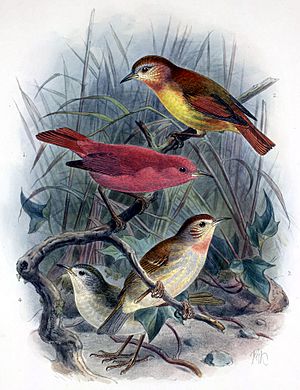Kākāwahie facts for kids
Quick facts for kids Kākāwahie |
|
|---|---|
 |
|
| Above: adult male and female. Below: juvenile male and female | |
| Conservation status | |
| Scientific classification | |
| Genus: |
Paroreomyza
|
| Species: |
flammea
|
The kākāwahie (pronounced kah-kah-WAH-hee-ay), also known as the Molokaʻi creeper, was a beautiful bird. It lived only on the Hawaiian island of Molokaʻi in Hawaii. This special bird was a type of Hawaiian honeycreeper. Sadly, it is now extinct, meaning it has completely disappeared from Earth. The last time anyone saw a kākāwahie was in 1963.
Contents
What the Kākāwahie Looked Like
The kākāwahie was about 5.5 in (14 cm) long. This is about the size of a small sparrow. The male birds were bright scarlet red all over. They looked like a small ball of flame! Female kākāwahie birds had a brownish color on their bellies.
Their call sounded like a "chip." Some people said it was like someone cutting wood far away. A British bird expert named Scott Barchard Wilson discovered these birds in the late 1800s. He was lost in the fog when he found them. He collected some birds to study. Even though they were fast, these birds were still endangered. The kākāwahie is shown in many old paintings.
Where the Kākāwahie Lived
The kākāwahie lived in the Akoke Forests on Molokaʻi. Their main home was in the Kamakou Plateau area. This is where they were seen before they disappeared in 1963.
How the Kākāwahie Lived
The kākāwahie used its short, blunt beak to find food. It would peck insects out of old naio (Myoporum sandwicense) trees. They mostly ate larvae (young insects) of beetles and lepidoptera (like caterpillars). Sometimes, they would also sip nectar from flowers, including the naio flower.
Their nests were reportedly made of moss on the outside. The scientific name for this bird is Paroreomyza flammea. This name means "flame-like" because of how red the males were. It also describes how they quickly moved from tree to tree looking for food.
Why the Kākāwahie Became Extinct
The kākāwahie became extinct for several reasons. These reasons are similar to why other Hawaiian forest birds disappeared.
One big problem was Habitat destruction. This means their forest homes were destroyed. Another issue was diseases spread by new mosquitoes. These mosquitoes carried illnesses like avian malaria and fowlpox. These diseases made the kākāwahie very sick. They could cause lumps, paralysis, and eventually death because the birds could not eat.
New animals that hunted the birds were also a problem. These animals were brought to the island by people.
Native Hawaiians sometimes caught these birds for their beautiful red feathers. These feathers were then used to make special capes and leis for the aliʻi (Hawaiian nobles and royalty).
The last confirmed sighting of the kākāwahie was in 1963. This was in a mountain wet forest area called ʻŌhiʻalele Plateau. There were a few reports of people seeing the bird until the 1970s. It is very unlikely, but some hope that a few might still exist in very remote parts of the Olokui plateau.
See also
 In Spanish: Kakawajie para niños
In Spanish: Kakawajie para niños


